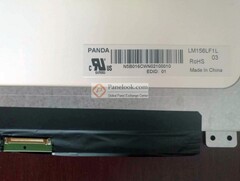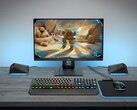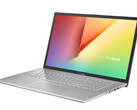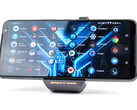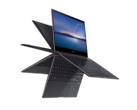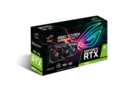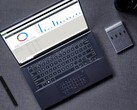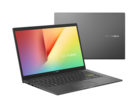To gamers, jumping from regular 60 Hz displays to ones capable of 120 Hz or greater can feel like night and day. The gaming experience will always be tangibly smoother and with improved responsiveness on a 120+ Hz monitor when compared to any 60 Hz option. Almost every high refresh rate panel on laptops have the added benefit of fast black-white response times and full sRGB coverage to minimize ghosting and allow for deeper colors as well, respectively.
We have to say "almost every high refresh rate panel" because at least one manufacturer is making cheap high refresh rate panels with both significantly slower black-white response times and limited colors. The Panda LM156LF series may have native refresh rates of 120 Hz or 144 Hz, but its black-white response times can be almost 3x slower and with a 30 percent narrower color range than similar options from BOE, LG Philips, AU Optronics, or others. These hidden drawbacks make laptops equipped with Panda panels substandard for gaming even though such panels are found exclusively on gaming laptops.
Our table below compares a number of reviewed gaming laptops equipped with the high refresh rate Panda LM156LF panel to other high refresh rate options from AU Optronics, Sharp, and LG Philips. Panels from Panda are consistently narrower in color range (60% sRGB vs. >90% sRGB) and with slower black-white response times (>13 ms vs. 4 ms to 7 ms) than those from any of the aforementioned alternatives. The differences aren't minor either as ghosting is more apparent and colors aren't as deep based on our experience with all of these laptops.
If you want the best high refresh panel on your next gaming laptop purchase, then we recommend avoiding these Panda options as their high native refresh rates are somewhat mitigated by their slower black-white response times and shallower color reproduction.
| Asus VivoBook 15 K571LI-PB71 Panda LM156LF-GL03, IPS, 15.60, 1920x1080 | Asus Strix GL531GV-PB74 Panda LM156LF-GL02, IPS, 15.60, 1920x1080 | SCHENKER Key 15 Comet Lake Panda LM156LF-1F02, IPS, 15.60, 1920x1080 | Asus TUF FX505DY Panda LM156LF-CL03, IPS, 15.60, 1920x1080 | Acer Nitro 5 AN515-44-R5FT Panda LM156LF-2F01 (NCP004D), IPS, 15.60, 1920x1080 | Asus ROG Zephyrus G15 GA502IU-ES76 Panda LM156LF-2F01, IPS, 15.60, 1920x1080 | Acer Aspire 5 A515-43-R6WW CEC PANDA LM156LF-CL07, IPS, 15.60, 1920x1080 | Asus ROG Strix G15 G512LI Panda LM156LF-2F01, IPS, 15.60, 1920x1080 | Asus TUF Gaming A15 FA506IV-HN172 LM156LF-2F01, IPS, 15.60, 1920x1080 | Razer Blade 15 RTX 2070 Super Max-Q AU Optronics B156HAN12.0, IPS, 15.60, 1920x1080 | MSI GS66 Stealth 10SE-045 Sharp LQ156M1JW03, IPS, 15.60, 1920x1080 | Lenovo Legion Y530-15ICH LG Display LP156WFG-SPB2, IPS, 15.60, 1920x1080 | |
|---|---|---|---|---|---|---|---|---|---|---|---|---|
| Display | 0% | 64% | 0% | 2% | -3% | -2% | -1% | -3% | 69% | 66% | 54% | |
| Display P3 Coverage | 40.2 | 40.13 0% | 67.2 67% | 40.04 0% | 41.16 2% | 38.9 -3% | 39.53 -2% | 39.73 -1% | 38.92 -3% | 69.4 73% | 67.5 68% | 62.5 55% |
| sRGB Coverage | 60.4 | 60.3 0% | 96.2 59% | 60.2 0% | 61.8 2% | 58.5 -3% | 59.5 -1% | 59.8 -1% | 58.5 -3% | 98.8 64% | 98.3 63% | 93 54% |
| AdobeRGB 1998 Coverage | 41.56 | 41.48 0% | 68.7 65% | 41.4 0% | 42.56 2% | 40.22 -3% | 40.84 -2% | 41.06 -1% | 40.22 -3% | 70.5 70% | 68.9 66% | 63.8 54% |
| Response Times | 1% | 64% | -43% | -35% | 4% | -16% | -17% | -10% | 78% | 58% | 51% | |
| Response Time Grey 50% / Grey 80% * | 28.4 ? | 26 ? 8% | 10 ? 65% | 44.8 ? -58% | 40.8 ? -44% | 24.4 ? 14% | 36 ? -27% | 33.6 ? -18% | 34 ? -20% | 3.2 ? 89% | 12 ? 58% | 15 ? 47% |
| Response Time Black / White * | 24 ? | 25.6 ? -7% | 9.2 ? 62% | 30.8 ? -28% | 30 ? -25% | 25.6 ? -7% | 25 ? -4% | 27.6 ? -15% | 24 ? -0% | 8 ? 67% | 10.4 ? 57% | 11 ? 54% |
| PWM Frequency | 20830 ? | 178 ? | 23580 ? | |||||||||
| Screen | -11% | 14% | 3% | 11% | 4% | 3% | -10% | 11% | 34% | 32% | 15% | |
| Brightness middle | 263.9 | 290.1 10% | 300 14% | 211.5 -20% | 287 9% | 255.9 -3% | 250 -5% | 271.2 3% | 280 6% | 345.4 31% | 272 3% | 305 16% |
| Brightness | 246 | 274 11% | 281 14% | 200 -19% | 271 10% | 246 0% | 228 -7% | 252 2% | 254 3% | 342 39% | 259 5% | 284 15% |
| Brightness Distribution | 87 | 86 -1% | 80 -8% | 82 -6% | 88 1% | 89 2% | 83 -5% | 79 -9% | 88 1% | 90 3% | 91 5% | 83 -5% |
| Black Level * | 0.26 | 0.54 -108% | 0.29 -12% | 0.23 12% | 0.25 4% | 0.22 15% | 0.205 21% | 0.53 -104% | 0.15 42% | 0.34 -31% | 0.27 -4% | 0.52 -100% |
| Contrast | 1015 | 537 -47% | 1034 2% | 920 -9% | 1148 13% | 1163 15% | 1220 20% | 512 -50% | 1867 84% | 1016 0% | 1007 -1% | 587 -42% |
| Colorchecker dE 2000 * | 5.56 | 5.16 7% | 5.39 3% | 3.92 29% | 4.77 14% | 5.15 7% | 5.65 -2% | 5.04 9% | 5.89 -6% | 3.18 43% | 2.42 56% | 3.63 35% |
| Colorchecker dE 2000 max. * | 16.11 | 18.09 -12% | 14.35 11% | 17.63 -9% | 17.15 -6% | 17.11 -6% | 13.7 15% | 16.07 -0% | 19 -18% | 6.57 59% | 6.93 57% | 8.18 49% |
| Colorchecker dE 2000 calibrated * | 4.3 | 4.35 -1% | 1.73 60% | 4.16 3% | 3.73 13% | 4.83 -12% | 4.26 1% | 4.79 -11% | 1.77 59% | 0.88 80% | 1.31 70% | |
| Greyscale dE 2000 * | 5.8 | 4.4 24% | 9.8 -69% | 3.1 47% | 2.7 53% | 4.2 28% | 6.32 -9% | 3.4 41% | 4.08 30% | 3.8 34% | 4.5 22% | 4.77 18% |
| Gamma | 2.16 102% | 2.1 105% | 2.019 109% | 2.23 99% | 2.115 104% | 2.16 102% | 2.45 90% | 2.09 105% | 2.33 94% | 2.15 102% | 2.188 101% | 2.54 87% |
| CCT | 7828 83% | 7362 88% | 8174 80% | 6578 99% | 7187 90% | 7500 87% | 7287 89% | 7079 92% | 7303 89% | 7109 91% | 7369 88% | 7500 87% |
| Color Space (Percent of AdobeRGB 1998) | 38.2 | 38.1 0% | 69 81% | 38.1 0% | 43 13% | 36.9 -3% | 38 -1% | 37.8 -1% | 37 -3% | 64.3 68% | 69 81% | 59 54% |
| Color Space (Percent of sRGB) | 60.1 | 60 0% | 92 53% | 60 0% | 61 1% | 58 -3% | 59 -2% | 59.5 -1% | 58 -3% | 99 65% | 91 51% | 93 55% |
| Total Average (Program / Settings) | -3% /
-7% | 47% /
29% | -13% /
-4% | -7% /
4% | 2% /
2% | -5% /
-1% | -9% /
-9% | -1% /
6% | 60% /
46% | 52% /
42% | 40% /
27% |
* ... smaller is better


 Deutsch
Deutsch English
English Español
Español Français
Français Italiano
Italiano Nederlands
Nederlands Polski
Polski Português
Português Русский
Русский Türkçe
Türkçe Svenska
Svenska Chinese
Chinese Magyar
Magyar